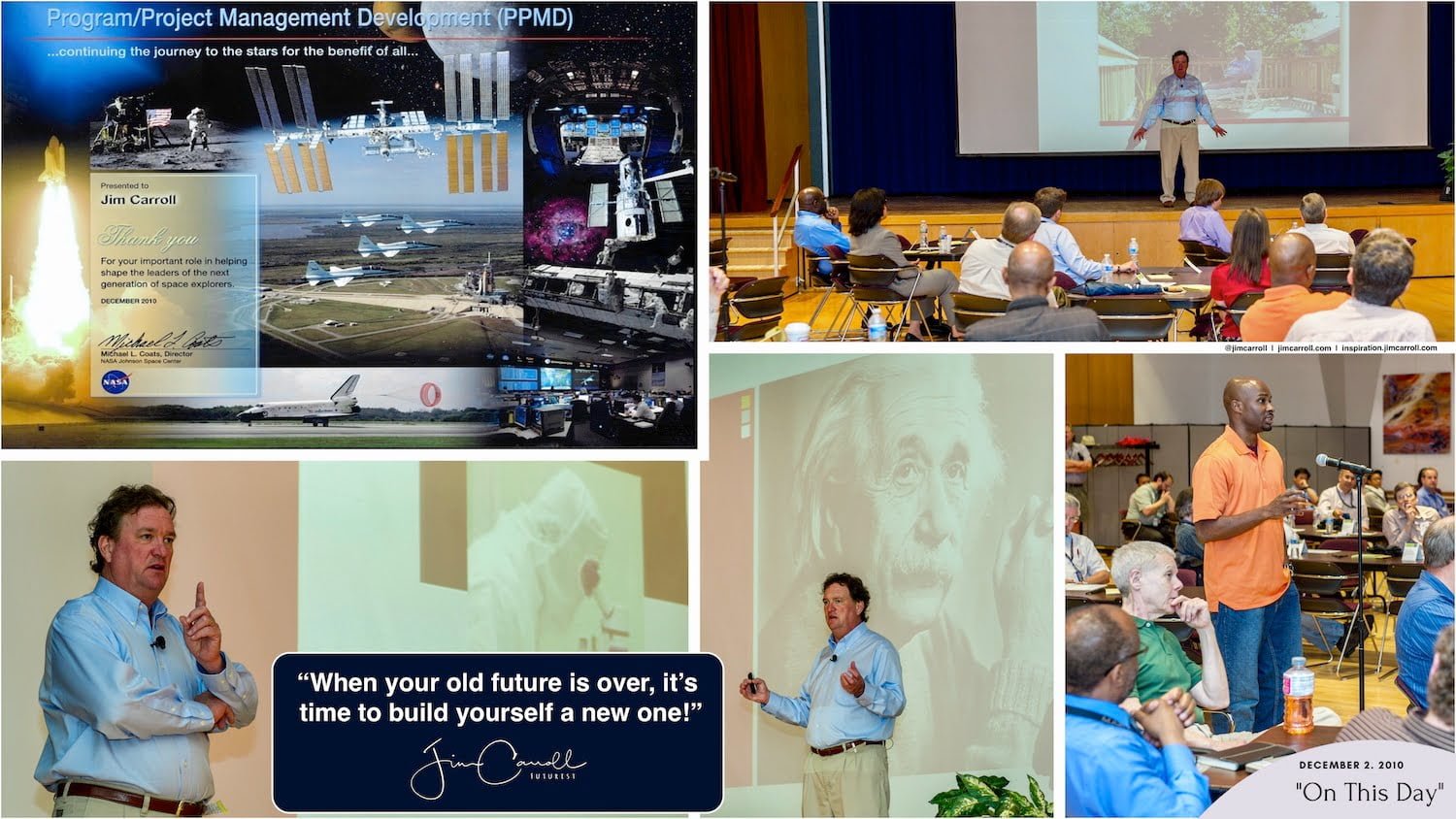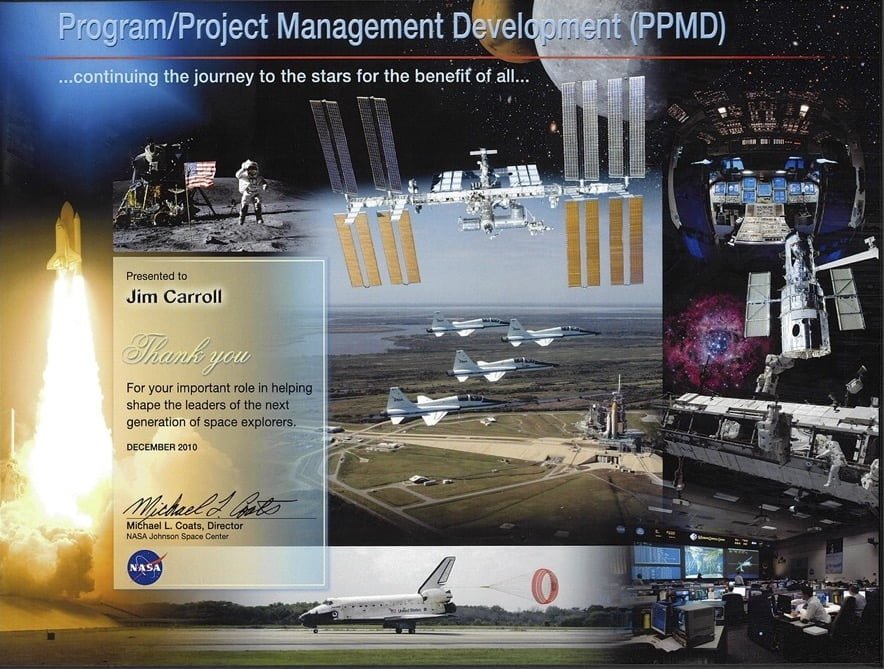“When your old future is over, it’s time to build yourself a new one!” – Futurist Jim Carroll

11 years ago yesterday, I gave a dinner keynote to a senior leadership team at NASA. What a crowd – astronauts, program managers, launch controllers, and literally, rocket engineers! As a long-time space nerd, being invited in as a FUTURIST to speak to NASA about the future of space was one of my biggest pinch-me moments. It was also one of my most challenging keynotes in the context of a potentially very difficult audience – learn why below. And so today, proudly hanging on my wall. is this particular memento, a reminder of key message : your old future is not guaranteed, and it’s your ability to adapt to a new one that will truly define you. What a message for our Covid times!

Here’s what you should know: there are lessons to be learned from what NASA was facing in 2010 and the key message in my talk, and what you are faced with today – the global pandemic and Covid-19 has forever shifted your future. What are you doing to align with your new reality? Back to my talk in 2010 – I was asked to speak to this group of mission commanders, project directors, various astronauts now involved in different roles — on the theme of “transformational leadership.” Going in, I knew this would be one of the toughest keynotes I would take on during my career – this would be a tough crowd! After all, NASA was at an extremely challenging phase, with a great degree of uncertainty with respect to its future role and mission. Astronauts? Certainly a lot of demanding, high-performance type-A personalities would be in the room. Gulp!
Yet, back in 2010, there were a lot of big, unanswered questions and issues surrounding the future of NASA; certainly, a lot of organizational trauma as the space shuttle program was being wound down; a great deal of uncertainty with new directions such as the commercialization of space flight; much internal debate as to whether the recently established direction is the “right” thing; budget cutbacks and constraints, and a society ready to challenge (as always) the importance of investment in space. exploration and commercialization.
11 years on? I 2021 is VERY different, with SpaceX and many other organizations playing a key role; the entire path for NASA has shifted in dramatic fashion. Back then – there were many folks who did not accept this future – and that was my mission. Many people throughout the organization had a hard time believing in such a future – NASA would always be the only organization in the business of space – or so was the belief! I was invited in to address that elephant, with a message around the idea of ‘transformational leadership.’ A pretty complicated situation! Given that, I was honored to be invited in to speak to them; personally, I was a bit overwhelmed, knowing this to be an extremely complex situation, with a group of leaders who might be all over the map in terms of their acceptance of the future reality.
So what did I talk about? My key goal was to go in and provide some insight as to what history has taught us as to what great leaders have done during a time of great transition, and what current leaders are doing right now to ensure they stay focused on innovation and the future.
In other words, what do leaders do during transformational times?
There were several key themes that I hit upon:
1. In a time of great change, great leaders work fast to shape the focus of their team.
It’s not as if NASA hasn’t been in this situation before; its history has been one full of volatility in terms of future direction. That’s a reality that comes from being a public institution funded by the shifting political winds which swirl around it.
In my dinner talk, I held up the example of what they were going through in 1993 when the International Space Station was at risk. “NASA officials allowed themselves Tuesday to talk about the possibility of life without the space station. They clearly didn’t enjoy the talk, but said the nation can still have a vigorous space program — and achieve many of the same goals — without the $31 billion project.” NASA imagines life without space station, Houston Chronicle, 28 April 1993
Of course, NASA got through that difficult period of time; it will go through more. Great leaders keep everyone focused on the future, however volatile it might be!
2. Great leaders provide a message of continuity despite uncertainty
NASA was in a period of great uncertainty from many different perspectives. Yet what great leaders have done in the past and keep on doing — in government, industry, and elsewhere — is to work fast to ensure that the team understands that there still is a future, even it if is a different future.
From the 1993 article: “If the space station is canceled, it is my inherent belief that we will continue to have a robust manned spaceflight program that includes science. There will be activities that will become alternative choices to a space station,” Arnold Aldrich, associate administrator of the space agency, told the space subcommittee of the House Science, Space, and Technology Committee.” NASA imagines life without space station, Houston Chronicle, 28 April 1993
What was so absolutely wonderful was that the fellow in the article showing that attitude — Alan Aldrich — was in the room in the room in 2010 as I spoke these words. I knew he was there in advance; he was speaking to the group earlier in the day. I presumed that he was of a transformational mindset as a leader, and I was delighted to discover his quote during the preparation of my talk. I gave him a shoutout – for me, it was a very emotional moment.
3. Transformational leaders refocus their team on the opportunities of the future by crystallizing innovation
Consider the next comment by Aldrich in the article: “In other words, I believe we would be very much driven to find alternative ways to meet the same primary goals of the Space Station Freedom.” NASA imagines life without space station, Houston Chronicle, 28 April 1993
4. Transformational leaders set the tone at the top.
The key message? We’ve got to challenge ourselves to accept our new realities, focus on the opportunities of the future rather than clinging to the glories of our past, and work hard to think and act differently to achieve our goals.
Did my talk work? Definitely: I had extremely positive feedback, with 79% of the group ranking my presentation as “above expectations” or “greatly above expectations.”
- “Good eye-opener brief and well timed at the end. I liked his fast-paced style. I did question his 3 global problems for the world – energy, environment, health care. Globally, food and water are the leading problems on the horizon”
- “Good info presented at a good time in the session”
- “Great presentation, great perspective, EXCELLENT on all accounts.”
- “Not big on motivational speakers, but thought Jim did a good job of drawing relevant parallels between NASA’s situation and other big companies. Appreciated his perspective on the importance of transitional leadership. Appreciate the fact he didn’t make a judgment about what the “right” or “wrong” side of the argument was, but rather how to be effective IN the environment”
- “Outstanding. Very thought provoking which I believe was the intent”
- “Thought-provoking”
- “I resonated with this speaker; it’s very hard, NASA needs more of this kind of attitude to more readily accept changes to explore/exploit opportunities”
Pretty amazing for a tough crowd. And yet, I will admit it was not all a bed of roses; a small number of folks in the room did not like my focus. 4% rated my presentation as below expectations. One participant commented: “It was an interesting presentation, but I wasn’t impressed with the content. I recognize the importance of being positive and optimistic and he captured that thought well. I just couldn’t relate to the entire conversation.”
I will admit that the unique job I have — challenging people to think about the future — can often be a difficult one. Particularly when people are in the midst of a very difficult transition. Going into the NASA gig, I knew I would be facing a tough audience. It’s a tough situation. Looking back, I’m kind of thrilled that I was able to make such a positive contribution when thinking about space exploration in 2021 — and to me, that’s what transformational leadership is all about. I knew I couldn’t get my message to everyone in the room – but it seems like it worked for the majority of them!
What’s the lesson for you? Going forward, the global pandemic and Covid-19 has forever shifted your future. What are you doing to align to reality? With that in mind, I hit the virtual broadcast studio last year to film a show around this keynote – covering the story above.




GET IN TOUCH
Jim's Facebook page
You'll find Jim's latest videos on Youtube
Mastodon. What's on Jim's mind? Check his feed!
LinkedIn - reach out to Jim for a professional connection!
Flickr! Get inspired! A massive archive of all of Jim's daily inspirational quotes!
Instagram - the home for Jim's motivational mind!